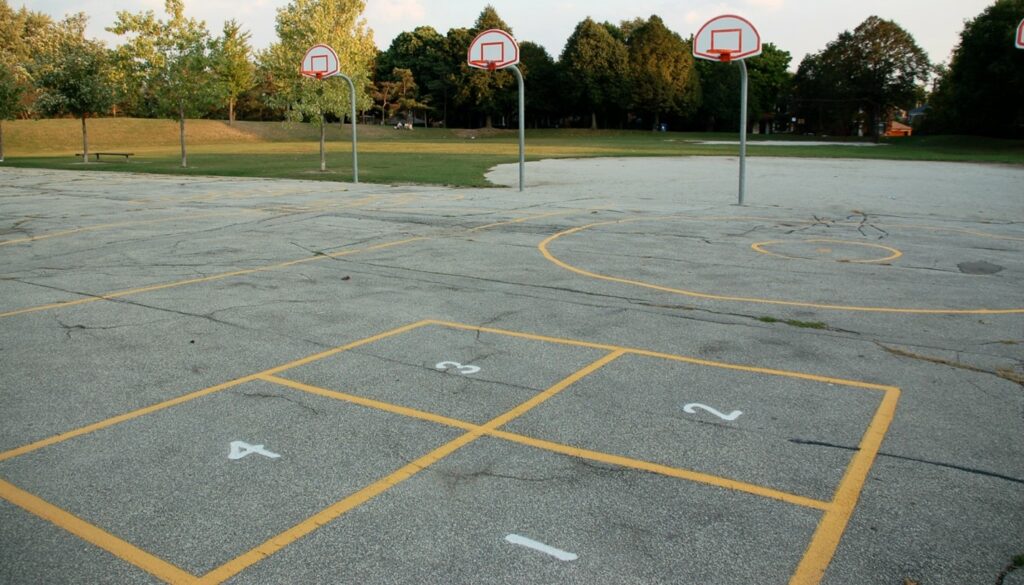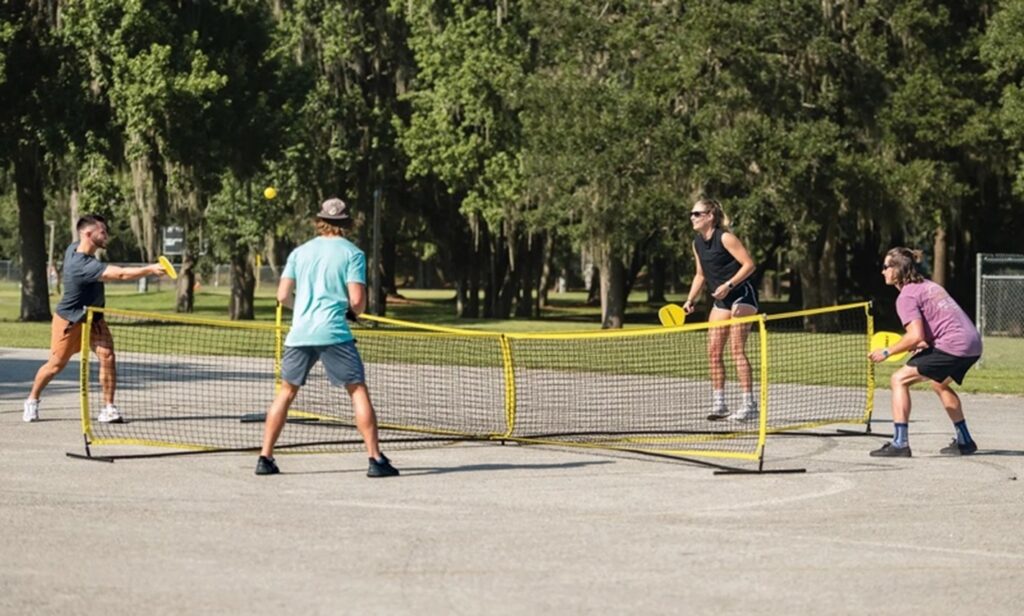
The physical education landscape is changing; from activities our students participate in outside of the classroom, uses of technology within the classroom, and options for students to choose their path in PE to name a few. However, in the mindset of all this change, we should revisit a playground classic, 4-square. When you make the right adjustments and put it into practice properly, 4-square can do a lot: it helps make good use of space, organizes and mixes students in a way that boosts activity time, focuses on a bunch of different skills and concepts, tackles SEL competencies, and even lets students shift how they see their own abilities. This affects not just their initial approach but also how successful they are throughout different physical education activities.
According to Carolyn Temertzoglou in her article posted on the Gopher Sport blog, “Non-Traditional Sports in PE” Carolyn references non-traditional games “provide new experiences, opportunities for positive social interaction, and develop movement competence within fun/joyful experiences.” Thinking about this in the mindset of 4-square, consider using traditional activities such as pickleball, badminton, eclipse ball, volleyball, and spikeball within a 4-square playing environment. Often students come into these “traditional” activities with preconceived notions about their own abilities and who they can or cannot work with. Through the use of 4-square, one can present learning targets around forehand/backhand, offensive/defensive strategy, and overhand striking to name a couple.
The Perfect Activity for Easy Grouping, Transitions, and Spacing!
The use of 4-square allows for efficient grouping, transitions, and space use within the classroom environment. Multiple group sizes including individual, partner, and groups of three or more depending on how many teams you have. These groups can rotate around the playing area, or off and on as needed in an easy-to-follow fashion with little to no wait time outside of the game. Furthermore, you can fit 4 or more courts within a gymnasium and can modify the size of each zone as well, allowing for higher numbers of students to be actively engaged in gameplay. Lastly, the rotation of 4-square follows an easy pattern where once a learning activity is implemented; the teacher can have more time to move around the space providing feedback.
How 4-Square Boosts Skill Development:
Traditional 4-Square: 4-square is an activity that challenges students to consider which zone and area within each zone to place their shot based on an opponent’s position, and even their position within the game. This is a great opportunity to create reflection and discussion to later learning activities within volleyball, tennis, and/or spikeball Skills Developed: Offense shot placement, defensive center position, movement to the ball.
Spikeball: Regarding Spikeball, students have the opportunity to focus on overhand striking and underhand passing with a larger target area to strike into. Students also have the opportunity to improve underhand passing/striking success by including the option to have one or more bounces between hits as well as implement a quick strike with an underhand hit into an opponent’s zone. Skills Developed: Overhand striking, Underhand passing/striking.
Tennis, Pickleball, Eclipse ball, Badminton: For tennis, pickleball, eclipse ball, and badminton, students have the ability to refine forehand and backhand striking ability through the removal of a net, increased focus on form instead of power within the smaller playing area, and the increased focus on the shot set up through movement and positioning of the feet. Skills Developed: Forehand/backhand.
Volleyball: Lastly, regarding volleyball which is similar to the 4-square modifications for spikeball and movement to the ball/body positioning, students have an increased chance at success with bumping, setting, getting multiple passes strung together, and if chosen spiking thanks to the lack of a net (unless playing crossnet) and multiple bounce rule. Skills Developed: Bump, set, multiple hits, spiking.
The Social-Emotional Benefits of 4-Square:
As stated on openphysed.org, traditional 4-square targets SEL competencies such as conflict resolution, relationship skills, self-management, and positive language. Students using non-traditional 4-square games will continue to work through these competencies. Whether playing individually or with a partner(s). For example, in conflict resolution, students will have to determine in vs out, legal vs illegal within the rules, and if playing with a partner what to do when in a disagreement over strategy selection. Relationship skills come in the form of communicating with a wide variety of teammates/classmates, positive language towards teammates/classmates, and inclusion of others. Self-management is displayed in how students handle winning/losing a point as well as how they handle conflict within the gameplay.
Teachers using 4-square in non-traditional ways also help students break down preconceived notions of competence and activity enjoyment; which both impact student motivation and mindset during learning activities. For example, consider activities like pickleball or spike ball within a 4-square setting. Students gain advantages from the smaller playing area. This setup promotes movement, allows them to concentrate on their striking techniques with a heightened emphasis on form, all while alleviating concerns about missing the net or failing to get the ball over. Additionally, the teacher can tailor rules to suit the entire group, as opposed to just a few individuals.
Economical and Flexible: Equipment Recommendations for 4-Square Fun!

4-Square is inherently a low equipment needs game on its own, with playing areas being outlined by painted lines, chalked lines, tape, cones, and/or jump ropes. Additionally, no matter the variation only one ball/object (such as a birdie) is needed per court (4-16 students depending on the variation used). If equipment such as paddles or racquets is limited, students who are on/off have the ability to share pieces of equipment to help make sure everyone gets a chance to participate without waiting in a long line for a piece of equipment. Furthermore, when exploring options such as badminton or pickleball, there are equipment options such as CrossNet, 4-square badminton nets or tennis/pickleball nets out there that can be purchased to help further facilitate authentic gameplay for that particular activity/learning target. Lastly, as stated before, if needed, the use of tape, cones, jump ropes, chalk, or paint can clearly mark different sizes of appropriate playing area sizes for different learning targets and/or group sizes.
Bringing 4-square into current standards and learning outcomes for students presents the opportunity to transform the classroom into a more engaging and successful learning environment. Whether through the use of specialized equipment such as cross net or chalk lines, a teacher’s creativity is the key ingredient to transforming this activity to meet the needs of your learners. I hope this blog has given you some ideas on how to recreate common games in a fresh new light for your students. Thank you for taking the time to read this blog and please share your thoughts and findings to gopher and professional learning communities to continue to push education forward!




